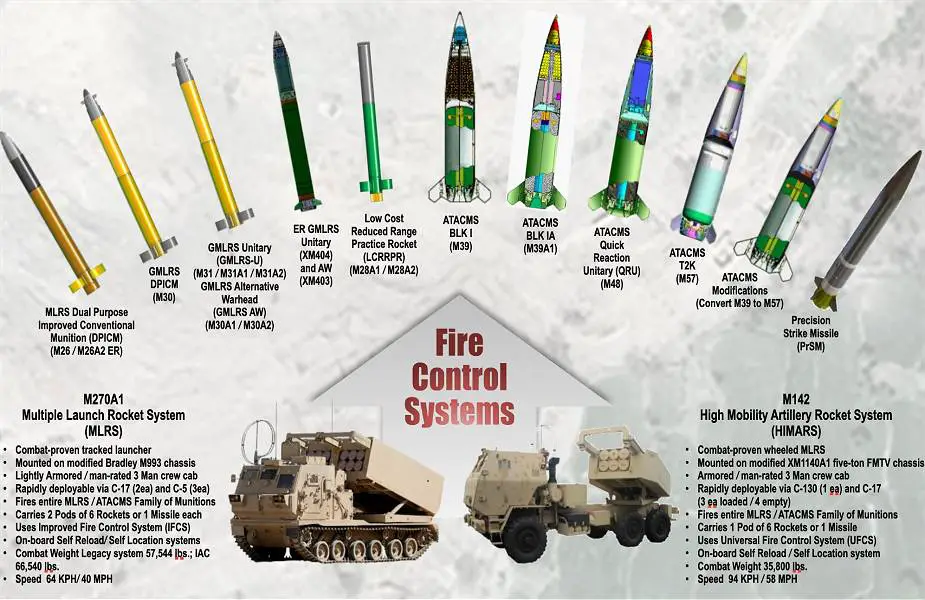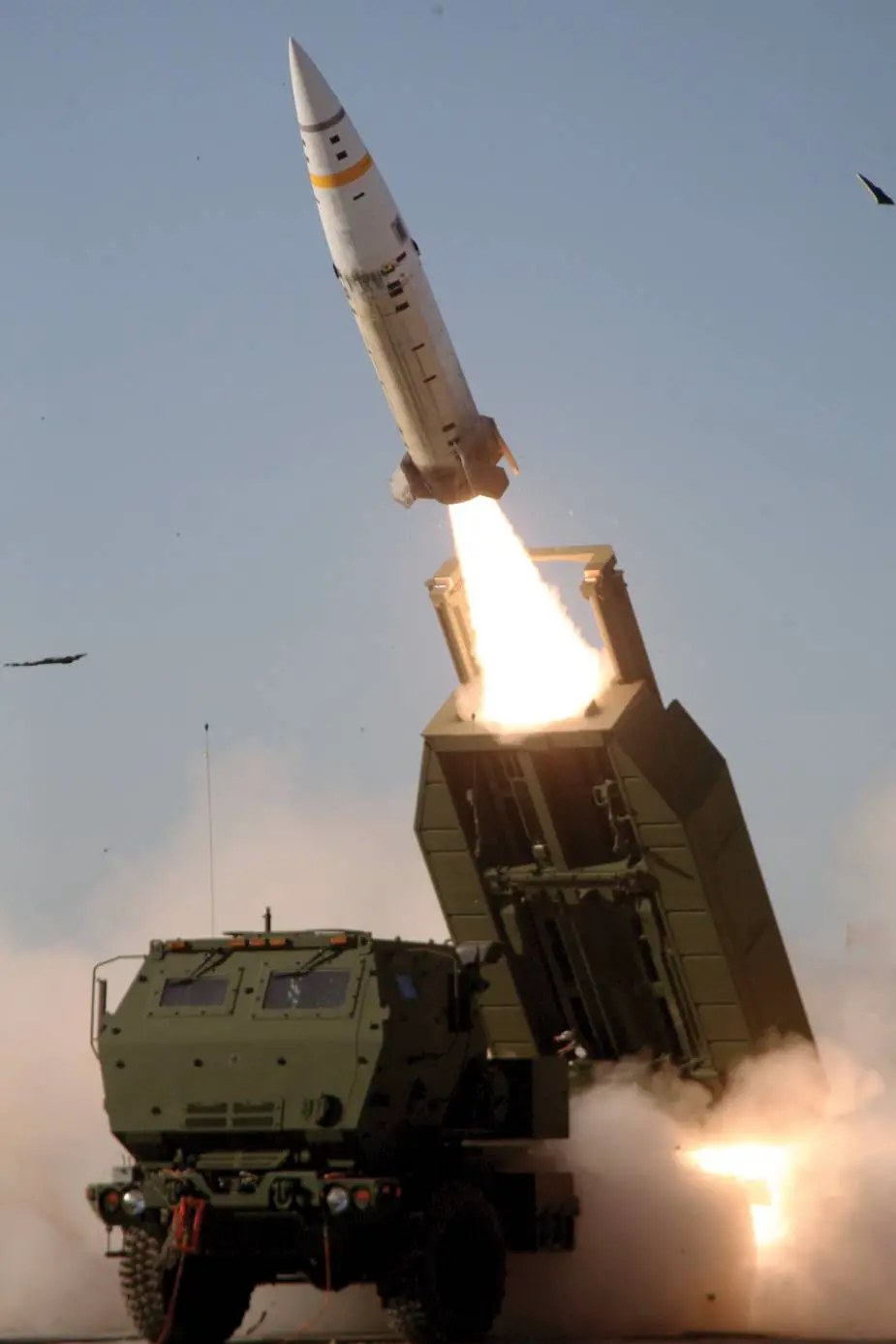Analysis: M270A1 IAC and M142 HIMARS are able to fire a wide range of rockets and missiles
The American-made M270A1 and M142 HIMARS (High Mobility Artillery Rocket System) are able to fire a wide range of rockets and missiles. Both vehicles are designed to support joint early and forced entry expeditionary operations with high-volume destructive, suppressive, and counter-battery fires.
Follow Army Recognition on Google News at this link

American-made M270A1 and M142 HIMARS are able to fire a wide range of rockets and missiles. (Picture source CAESAR Twitter account)
The M270A1 IAC is the latest generation of rocket launcher systems in the family of M270. It is an improved variant of the M270 that was developed following a requirement of the U.S. Army to modernize the M270 that entered into service with the U.S. Army in 1983. The M270A1 IAC is fitted with an Improved Armor Cab (IAC) and mine protective seats to increase protection against mine blast and IEDs (Improvised Explosive Devices).
The M270A1 IAC is based on an M993 tracked chassis which is a derivative of the Bradley Fighting Vehicle chassis.
The M270A1 IAC is designed to protect the crew against various direct fire, mine blast, and underbody fragmenting improvised explosive device threats. The M270A1 IAC is an Engineering Change Proposal to the M270A1 and does not impact the launcher’s system performance or the tactics, techniques, or procedures used during tactical operations. It has a crew of three and all the firing operations can be performed from inside of the crew cab.

M270A1 MLRS during live firing exercise. (Picture U.S. DoD)
The M142 High Mobility Artillery Rocket System (HIMARS) is a light multiple rocket and missile launcher system developed in the late 1990s by the American company Lockheed Martin for the United States Army. The vehicle is based on a standard Army M1140A1 6x6 truck chassis.
The M142 HIMARS has also a crew of three and it is twice lighter than the M270 with a weight of 16,240 kg. It can be easily transported by military transport aircraft C-130 or C-17 with 3 loaded or 4 empty M142 HIMARS.
The M270A1 IAC is fitted with two pods of six tube launchers while the M142 HIMARS has one single pod with six launcher tubes. In this configuration, both vehicles are able to fire different types of rockets including the M26 / M26A2Er Dual Purpose Improved Conventional Munitions (DPICM), M30 GMLRS DPICM, M31 / M31A1 / m31A2 GMLRS Unitary (GMLRS-U), M30A1 / M30A2 GMLRS Alternative Warhead (GMLRS AW), XM404 /XM403 ER GMLRS RS Unitary and the M28A1 / M28A2 Low Cost Reduced Range Practice Rocket (LCRRPR).

The M57A1 Army Tactical Missile System missile is fired over the cab of an M142 High Mobility Artillery Rocket System launcher. (Picture source U.S. DoD)
The M270A1 IAC and the M142 HIMARS are also able to fire missiles, in this configuration, the M270 can carry two missiles while the M142 only one. Both are able to fire ATACMS (Army Tactical Missile System) including a full family of surface-to-surface missiles as the MGM-140A Block 1 previously M39 that contains 950 M74 anti-personnel/anti-materiel (APAM) sub-munitions (4.275 kg) with a range of 80 130 km.
The ATACMS missile family also includes the MGM-140B previously named M39A1 which is a guided missile carrying 275 M74 sub-munitions and has a range of 165 km. The M48 Quick Reaction Unitary is a guided missile carrying a 225 kg explosive warhead used to engage a single target with minimal collateral damage with a range from 70 to 300 km. The M57 ATACMS 2000 Unitary (T2K) is fitted with a single warhead and a range from 70 to 300 km. The missile has an improved Navigation and Guidance capability, an all-in-view GPS receiver, an improved Control Actuator System (CAS) and Electronic Control Unit (EUC), and a more reliable, repeatable fuse.
And finally, the Precision Strike Missile (PrSM) is a surface-to-surface, all-weather, precision-strike guided missile that can be fired from the M270A1 Multiple Launch Rocket System (MLRS) and the M142 High Mobility Artillery Rocket System (HIMARS). The baseline missile, which will be developed and fielded to engage a wide variety of targets at ranges up to 499 km, will emphasize imprecisely located area and point targets. The primary emphasis for follow-on spirals will be on the increased range, lethality and engagement of time-sensitive, moving, hardened and fleeting targets.
The PrSM will destroy/neutralize/suppress targets at ranges from 70-400-plus km using missile-delivered indirect precision fires. PrSM provides field artillery units with long-range and deep-strike capability while supporting brigade, division, corps, Army, theater, joint/coalition forces and Marine Air-Ground Task Forces in full, limited, or expeditionary operations. The PrSM will replace the existing aged inventory of non-Insensitive Munitions and Cluster Munition policy-compliant Army Tactical Missile Systems (ATACMS).


























